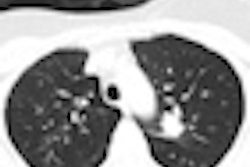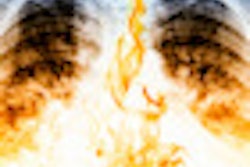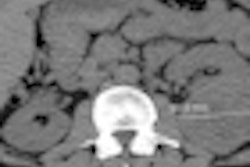In one of the first studies to address treatment after CT lung cancer screening detects a malignancy, a new study in the Journal of Thoracic Oncology found that more than 80% of lung cancer resections could be performed successfully with video-assisted thoracic surgery (VATS), sparing the pain and cost of more invasive options.
As clinicians cope with the daunting task of tracking, following up with, and referring patients with lung nodules detected in screening, they should consider the use of VATS as a less invasive alternative to biopsy and open thoracotomy, according to Dr. René Petersen and colleagues, who treated participants in the Danish Lung Cancer Screening Trial, a randomized clinically controlled trial of more than 4,000 smokers between 2004 and 2006.
"Most of the papers published so far about CT screening are concerned about the radiology part -- that is, the detection of the nodules and other aspects of CT screening -- but only a few papers have addressed the surgical part of screening, Petersen said in an interview with AuntMinnieEurope.com.
Lung cancer screening has generated enormous interest in the wake of a 2011 report from the U.S. National Lung Screening Trial showing a 20% mortality reduction when tumors are caught early and resected. Facilities are looking for ways to gear up their screening programs in cost-effective ways.
Several publications have demonstrated the safety and oncologic efficacy of VATS lobectomy in early-stage lung cancer, wrote Petersen and colleagues from Copenhagen University's Rigshospitalet in Copenhagen.
"Advantages reported for VATS lobectomy include reduced perioperative pain, shorter hospital stay, more rapid resumption of normal daily activities, less impairment in pulmonary function postoperatively, less impairment in shoulder function, reduced cytokine release, improved delivery of adjuvant chemotherapy, lower incidence of complications, and economical advantages," they wrote (Journal of Thoracic Oncology, June 2012, Vol. 7:6, pp. 1026-1031).
VATS is also easier on the patient. In contrast to the small chest openings required for VATS to accommodate the video camera, the specimen, and instruments, open thoracotomy is a major surgical maneuver undertaken to gain wide access to the chest. It involves more healing time, longer hospital stays, and greater risk and cost, the authors wrote.
In a pinch, VATS can also replace a job that has traditionally been the purview of the interventional radiologist -- that of using CT guidance to biopsy suspicious nodules, which are sometimes too small to target effectively, Petersen told AuntMinnieEurope.com.
"Of course we prefer to do CT-guided biopsies of suspicious lesions, but the success rate is not very high in lesions smaller than 1 cm," he said. "What we did in those patients was a VATS wedge resection using frozen section pathology," Petersen said. Twenty to 30 minutes later, pathology reports on whether it's malignant or not, "and if it's malignant, I do the lobectomy straight away during the same procedure."
In the U.S., patients may typically go to the radiologist who performs the CT scan, and when indicated, are referred to a preferred thoracic surgeon, Petersen said.
"We think it's important for thoracic surgeons to be involved early in the process to evaluate whether a nodule is suspicious at all -- and do what we can to get better knowledge of that," he said.
In the Danish Lung Cancer Screening Trial that Petersen, Dr. Henrik Hansen, Dr. Asger Dirksen, and colleagues followed up on, the 4,104 participating smokers and former smokers were randomized to either screening with five annual low-dose CT scans or no screening. The major end point was the effect of CT screening on lung cancer mortality and treatment options.
Petersen and colleagues monitored all diagnostic and treatment interventions in both groups prospectively until one to three years after the last screening round.
As of March 2011, 68 cases of lung cancer had been detected in the screening group, and seven patients with a benign nodule underwent surgical treatment due to suspicion of malignancy (12%), the group reported.
Fifty-one of the 68 lung cancer patients were eligible for surgical treatment, and eight of these patients underwent open thoracotomy in the form of muscle-sparing posteroilateral operations.
In total, 58 operations were performed in the CT screening arm, and the final histology was benign in seven cases (12%, 95% confidence interval: 5%-23%), the researchers wrote.
Of all operations for lung cancer, 84% were performed by VATS in the CT screened arm, significantly higher than the control arm (p < 0.05), Petersen and colleagues reported. Thirty-six patients had a VATS lobectomy. One patient had a VATS segmentectomy, and four patients had a VATS wedge resection.
All seven patients with a benign nodule were treated with a VATS procedure, including six with a VATS wedge resection and one patient who underwent a VATS lobectomy because of the central location of the nodule.
"There were practically no complications in these cases," Petersen said. "That's your major concern in screening -- the risk that you risk harming healthy patients if you use thoracotomy."
For those that are not benign, the question is how to treat the disease, he said. Most institutions do a thoracotomy and lobectomy, but with small tumors in early lung cancer, it's very easy to do a lobectomy with VATS.
In fact, the team was able "to perform minimally invasive VATS in 84% of the patients who had lung cancer discovered during the screening in the CT screening arm," Petersen said. "That's significant I think because there's been no one so far who has shown a VATS rate like that."
Petersen's institution has performed more than 1,000 VATS procedures, and interest is rising in the procedure across Europe, he said. More and more European centers are able to do VATS, though the University of California, Los Angeles still leads the world in procedure volume, he said.
"We think when you begin a CT screening program it's important to have VATS surgeons on your team," Petersen said. In fact, "screening should be done in areas where you have the possibility to send patients to VATS surgeries."



















